中国文化英文介绍
中国文化介绍英文版Chinese Culture introduction
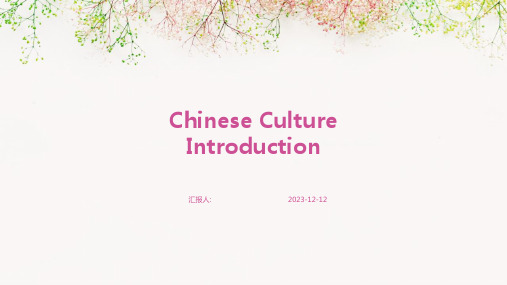
The commonly used techniques and styles in Chinese painting include ink painting, meticulous painting, freehand brushwork, etc., each with its unique aesthetic value and artistic expression.
Chinese Ceramics and Chinese Knives
Chinese porcelain is most famous for porcelain from Jingdezhen, Longquan Kiln, and other places, with a history dating back to the Tang Dynasty.
03
Buddhism and Zen Buddhism have a deep impact on Chinese culture, including Chinese poetry, calligraphy, painting, music, and folk customs They also spread to other countries and regions in the world
The Origin of Chinese Culture
The origin of Chinese culture can be traced back to the Yellow River basin, which is considered the slogan of Chinese civilization The Yellow River is an important river in China that has nurtured the growth of many urban civilizations
英文介绍中国传统文化
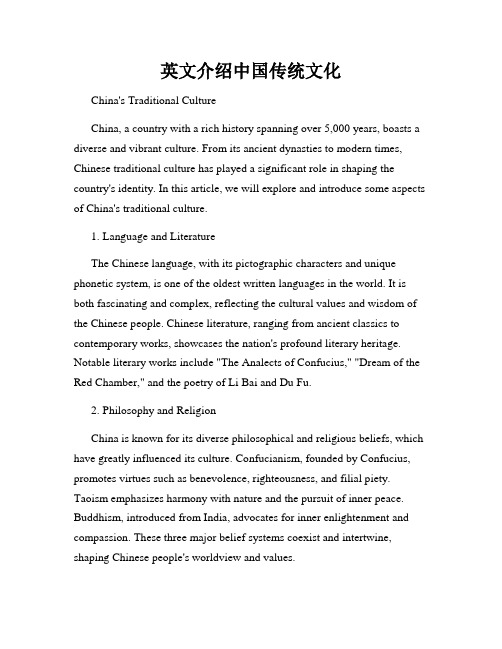
英文介绍中国传统文化China's Traditional CultureChina, a country with a rich history spanning over 5,000 years, boasts a diverse and vibrant culture. From its ancient dynasties to modern times, Chinese traditional culture has played a significant role in shaping the country's identity. In this article, we will explore and introduce some aspects of China's traditional culture.1. Language and LiteratureThe Chinese language, with its pictographic characters and unique phonetic system, is one of the oldest written languages in the world. It is both fascinating and complex, reflecting the cultural values and wisdom of the Chinese people. Chinese literature, ranging from ancient classics to contemporary works, showcases the nation's profound literary heritage. Notable literary works include "The Analects of Confucius," "Dream of the Red Chamber," and the poetry of Li Bai and Du Fu.2. Philosophy and ReligionChina is known for its diverse philosophical and religious beliefs, which have greatly influenced its culture. Confucianism, founded by Confucius, promotes virtues such as benevolence, righteousness, and filial piety. Taoism emphasizes harmony with nature and the pursuit of inner peace. Buddhism, introduced from India, advocates for inner enlightenment and compassion. These three major belief systems coexist and intertwine, shaping Chinese people's worldview and values.3. Traditional FestivalsChina has a wide array of traditional festivals, each with its unique customs and significance. The most well-known is the Spring Festival, also known as Chinese New Year, which marks the beginning of the lunar calendar. During this time, families gather for reunion dinners, exchange red envelopes containing money, and set off fireworks to ward off evil spirits. Other important festivals include the Lantern Festival, Qingming Festival, Dragon Boat Festival, Mid-Autumn Festival, and Double Ninth Festival.4. Traditional ArtsChinese traditional arts cover a broad range of disciplines, including calligraphy, painting, pottery, sculpture, opera, and martial arts. Calligraphy, regarded as a visual art form, embodies a spiritual expression of beauty and harmony. Chinese painting, characterized by brushstrokes and ink washes, often depicts landscapes, flowers, and birds. Traditional Chinese opera combines music, dance, and elaborate costumes to tell stories from Chinese history and folklore.5. Traditional Sports and GamesThroughout history, the Chinese have valued physical health and fitness. Traditional sports and games such as martial arts, table tennis, badminton, and mahjong have become deeply rooted in Chinese culture. Martial arts, such as Tai Chi and Kung Fu, not only promote physical well-being but also encompass a philosophical and spiritual dimension.6. CuisineChinese cuisine, with its diverse regional flavors and cooking styles, is renowned worldwide. From Sichuan spicy hot pot to Cantonese dim sum, each region has its unique culinary traditions. Chinese cuisine emphasizes the balance of flavors, textures, and colors. It includes a wide variety of ingredients and cooking techniques, demonstrating the Chinese people's deep appreciation for food and dining etiquette.ConclusionChina's traditional culture, with its rich heritage and diverse expressions, continues to be an essential part of its national identity. The language, literature, philosophy, festivals, arts, sports, and cuisine embody the values and traditions that have been passed down through generations. Understanding and appreciating China's traditional culture not only enhances our knowledge but also promotes cultural exchange and mutual respect in an increasingly interconnected world.。
介绍中国文化的英语作文

介绍中国文化的英语作文英文回答:China is a country with a rich and diverse culture that dates back thousands of years. Chinese culture is known for its traditions, customs, and values that have been passed down through generations. One of the most important aspects of Chinese culture is the concept of filial piety, which emphasizes the importance of respecting and caring forone's parents and elders. This value is deeply ingrained in Chinese society and is reflected in various customs and rituals, such as the annual Qingming Festival, where people pay respects to their ancestors.Another prominent aspect of Chinese culture is the emphasis on harmony and balance. This is evident in various practices such as traditional Chinese medicine, which focuses on restoring balance within the body to achieve optimal health. Additionally, the concept of yin and yang, representing the balance of opposing forces, is afundamental principle in Chinese philosophy and isreflected in various aspects of Chinese culture, including martial arts, feng shui, and even cuisine.Chinese culture also places a strong emphasis on family and community. Family is considered the cornerstone of society, and there is a strong sense of obligation to support and care for one's family members. This isreflected in traditional Chinese values such as loyalty, respect, and collectivism. For example, the Chinese NewYear is a time for families to come together and celebrate, and it is considered a time for reconciliation and renewalof family ties.In addition to these values, Chinese culture is also known for its rich history and traditions, including its art, music, literature, and cuisine. Traditional Chinese art, such as calligraphy and painting, often reflects the natural world and the harmony of the universe. Chinese music, such as traditional opera and folk songs, is knownfor its melodic and rhythmic complexity. Chinese literature, including classic works such as "The Romance of the ThreeKingdoms" and "Journey to the West," reflects the valuesand beliefs of Chinese society. And Chinese cuisine, withits diverse flavors and regional specialties, is areflection of the country's vast and varied landscape.Overall, Chinese culture is a complex and multifaceted tapestry of traditions, values, and customs that have been shaped by thousands of years of history. It is a culturethat is deeply rooted in the past but continues to evolve and adapt to the modern world.中文回答:中国是一个拥有丰富多彩文化的国家,其文化可以追溯数千年。
中国文化的英文范文
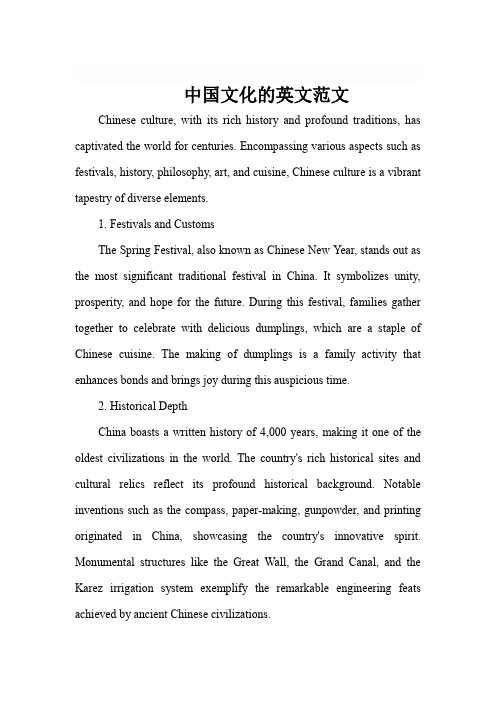
中国文化的英文范文Chinese culture, with its rich history and profound traditions, has captivated the world for centuries. Encompassing various aspects such as festivals, history, philosophy, art, and cuisine, Chinese culture is a vibrant tapestry of diverse elements.1. Festivals and CustomsThe Spring Festival, also known as Chinese New Year, stands out as the most significant traditional festival in China. It symbolizes unity, prosperity, and hope for the future. During this festival, families gather together to celebrate with delicious dumplings, which are a staple of Chinese cuisine. The making of dumplings is a family activity that enhances bonds and brings joy during this auspicious time.2. Historical DepthChina boasts a written history of 4,000 years, making it one of the oldest civilizations in the world. The country's rich historical sites and cultural relics reflect its profound historical background. Notable inventions such as the compass, paper-making, gunpowder, and printing originated in China, showcasing the country's innovative spirit. Monumental structures like the Great Wall, the Grand Canal, and the Karez irrigation system exemplify the remarkable engineering feats achieved by ancient Chinese civilizations.3. Philosophical WisdomChinese philosophy, deeply rooted in Confucianism, Taoism, and Buddhism, has shaped the country's societal values and ethics. These philosophical teachings emphasize harmony, respect, and the pursuit of knowledge, which are reflected in Chinese people's daily lives and social interactions. The wisdom of ancient Chinese philosophers continues to inspire individuals worldwide.4. Artistic ExpressionsChinese art, with its variety of forms such as Tang poetry, Song Ci, calligraphy, blue and white porcelain, and traditional Chinese musical instruments like the erhu and guzheng, demonstrates the country's rich artistic heritage. These artistic expressions have evolved over time, blending traditional and modern elements to create a unique aesthetic that is admired globally.5. Culinary DelightsChinese cuisine is renowned worldwide for its diverse flavors and cooking techniques. From spicy Sichuan dishes to the delicate flavors of Cantonese cuisine, each regional cuisine offers a unique taste experience. The documentary series "A Bite of China" has showcased the stories behind various foods, highlighting the connection between food and local cultures, traditions, and people's lives.In conclusion, Chinese culture is a vibrant amalgamation ofhistorical depth, philosophical wisdom, artistic expressions, and culinary delights. It continues to evolve while preserving its ancient traditions, making it a fascinating and enriching experience to explore.。
有关中国传统文化的英文作文三篇
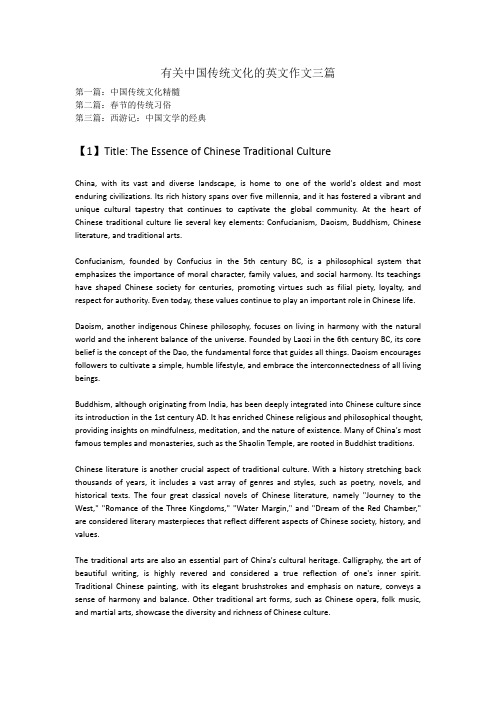
有关中国传统文化的英文作文三篇第一篇:中国传统文化精髓第二篇:春节的传统习俗第三篇:西游记:中国文学的经典【1】Title: The Essence of Chinese Traditional CultureChina, with its vast and diverse landscape, is home to one of the world's oldest and most enduring civilizations. Its rich history spans over five millennia, and it has fostered a vibrant and unique cultural tapestry that continues to captivate the global community. At the heart of Chinese traditional culture lie several key elements: Confucianism, Daoism, Buddhism, Chinese literature, and traditional arts.Confucianism, founded by Confucius in the 5th century BC, is a philosophical system that emphasizes the importance of moral character, family values, and social harmony. Its teachings have shaped Chinese society for centuries, promoting virtues such as filial piety, loyalty, and respect for authority. Even today, these values continue to play an important role in Chinese life.Daoism, another indigenous Chinese philosophy, focuses on living in harmony with the natural world and the inherent balance of the universe. Founded by Laozi in the 6th century BC, its core belief is the concept of the Dao, the fundamental force that guides all things. Daoism encourages followers to cultivate a simple, humble lifestyle, and embrace the interconnectedness of all living beings.Buddhism, although originating from India, has been deeply integrated into Chinese culture since its introduction in the 1st century AD. It has enriched Chinese religious and philosophical thought, providing insights on mindfulness, meditation, and the nature of existence. Many of China's most famous temples and monasteries, such as the Shaolin Temple, are rooted in Buddhist traditions.Chinese literature is another crucial aspect of traditional culture. With a history stretching back thousands of years, it includes a vast array of genres and styles, such as poetry, novels, and historical texts. The four great classical novels of Chinese literature, namely "Journey to the West," "Romance of the Three Kingdoms," "Water Margin," and "Dream of the Red Chamber," are considered literary masterpieces that reflect different aspects of Chinese society, history, and values.The traditional arts are also an essential part of China's cultural heritage. Calligraphy, the art of beautiful writing, is highly revered and considered a true reflection of one's inner spirit. Traditional Chinese painting, with its elegant brushstrokes and emphasis on nature, conveys a sense of harmony and balance. Other traditional art forms, such as Chinese opera, folk music, and martial arts, showcase the diversity and richness of Chinese culture.In conclusion, Chinese traditional culture is a multifaceted and enduring reflection of the nation's history, values, and beliefs. Its impact can be felt not only within China but also across the globe, as people from all walks of life are drawn to its unique charm and wisdom. As the world continues to evolve, Chinese traditional culture remains a source of inspiration and pride for the Chinese people and a testament to the resilience and creativity of human civilization.【2】Title: The Customs and Traditions of Chinese Spring FestivalThe Chinese Spring Festival, also known as Lunar New Year, is the most important and widely-celebrated holiday in China. It marks the beginning of the lunar calendar and is a time when families come together to welcome the new year with joy and prosperity. Rooted in centuries-old traditions, the Spring Festival embodies a rich tapestry of customs that have been passed down through generations. Here, we will delve into some of the most significant and fascinating practices associated with the festival.Preparations for the Spring Festival begin weeks in advance, with families cleaning their homes from top to bottom in a ritual known as "sweeping away the bad luck." This thorough cleaning is symbolic of driving away negative energy and making room for good fortune in the coming year. Homes are also adorned with red decorations, including lanterns, couplets, and paper cutouts, which represent happiness, prosperity, and good luck. Red, an auspicious color in Chinese culture, is believed to ward off evil spirits and bring good fortune.On the eve of the Spring Festival, families gather for a sumptuous reunion dinner, which is considered the most important meal of the year. The dinner table is laden with an array of dishes, each symbolizing a specific blessing for the new year. Fish, for example, represents abundance, while dumplings, with their-shaped like ancient gold ingots, symbolize wealth and prosperity. Family members indulge in these delicacies, sharing laughter and conversation as they usher in the new year together.One of the most well-known customs of the Spring Festival is the giving and receiving of red envelopes or "hongbao," which are filled with money. Traditionally, these envelopes are given by elders to younger family members as a symbol of their blessings and good wishes. The money inside the envelopes is believed to ward off evil spirits and bring good luck to the recipients in the coming year.Fireworks and firecrackers are also a prominent feature of the Spring Festival, as their loud explosions are believed to scare away evil spirits. Families and communities come together to light fireworks, filling the night sky with a dazzling spectacle of colors and sounds. This tradition has persisted for centuries, although some modern cities have introduced restrictions on fireworks to reduce air pollution and ensure safety.The Spring Festival celebrations culminate with the Lantern Festival, which falls on the fifteenthday of the first lunar month. During this time, streets and parks are illuminated with colorful lanterns, and people participate in riddle-solving games, enjoy traditional performances, and indulge in glutinous rice balls called "tangyuan," symbolizing family unity and togetherness.In conclusion, the customs and traditions of the Chinese Spring Festival reflect the richness and depth of Chinese culture. They embody the values of family, unity, and prosperity, while offering a fascinating glimpse into the beliefs and practices that have been passed down through generations. As the world becomes increasingly interconnected, the Spring Festival continues to captivate people of diverse cultures, who are drawn to its vibrant colors, tantalizing flavors, and profound symbolism.【3】Title: Journey to the West: A Classic of Chinese Literature"Journey to the West," also known as "Xiyouji" in Chinese, is one of the Four Great Classical Novels of Chinese literature. Written during the Ming Dynasty by Wu Cheng'en, the novel is a captivating blend of myth, legend, and adventure that has captured the hearts and imaginations of readers for centuries. This literary masterpiece not only provides a fascinating glimpse into Chinese history, culture, and beliefs, but also serves as a powerful allegory for spiritual growth and self-improvement.The story of "Journey to the West" is centered on the legendary pilgrimage of a Buddhist monk named Xuanzang, who travels from China to India in search of sacred Buddhist scriptures. Accompanying him on his perilous journey are four supernatural beings: Sun Wukong, the mischievous and resourceful Monkey King; Zhu Bajie, a pig-human hybrid with insatiable appetites for food and lust; Sha Wujing, a diligent and dependable river monster; and a white dragon horse that serves as Xuanzang's steed.Throughout the journey, Xuanzang and his companions encounter a myriad of challenges, including powerful demons, treacherous landscapes, and moral dilemmas. Each challenge serves as a test of their character, wisdom, and faith, ultimately shaping them into more virtuous and enlightened beings. While the narrative is filled with action, humor, and suspense, it also carries a deeper message about the importance of perseverance, compassion, and the transformative power of spiritual growth."Journey to the West" is notable for its rich and vivid portrayal of Chinese culture and mythology. The novel is steeped in Chinese folktales, legends, and Buddhist teachings, offering a unique window into the beliefs and values of ancient China. The characters in the story embody various aspects of human nature, such as courage, loyalty, cunning, and desire, providing valuable insights into the human condition.Furthermore, the novel has had a lasting impact on both Chinese and world literature. The character of Sun Wukong, the Monkey King, has become a symbol of rebellion, resourcefulness, and intelligence in Chinese culture. He has inspired countless adaptations, reinterpretations, andspin-offs, including the popular Japanese manga and anime series "Dragon Ball," which draws heavily from the character and themes of "Journey to the West."In conclusion, "Journey to the West" is a timeless classic of Chinese literature that continues to captivate and inspire readers from all walks of life. Its rich narrative, unforgettable characters, and profound messages about spiritual growth, resilience, and the human condition have solidified its status as a literary masterpiece. As the world becomes increasingly interconnected, the enduring appeal of "Journey to the West" is a testament to the power of stories to transcend cultural boundaries and unite people through the shared experience of imagination and wonder.。
中华传统文化英文介绍
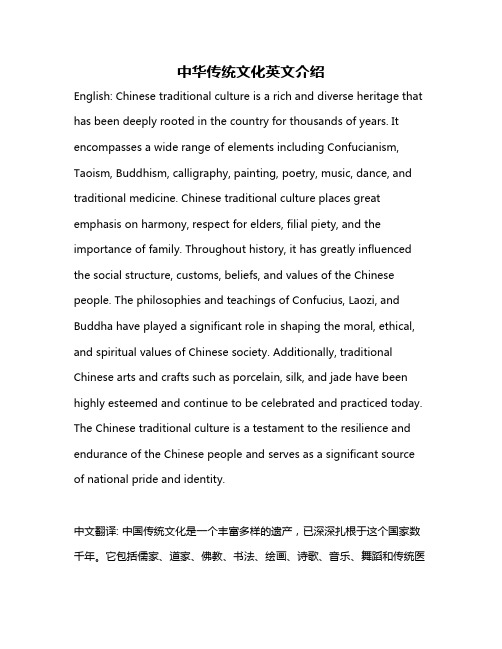
中华传统文化英文介绍English: Chinese traditional culture is a rich and diverse heritage that has been deeply rooted in the country for thousands of years. It encompasses a wide range of elements including Confucianism, Taoism, Buddhism, calligraphy, painting, poetry, music, dance, and traditional medicine. Chinese traditional culture places great emphasis on harmony, respect for elders, filial piety, and the importance of family. Throughout history, it has greatly influenced the social structure, customs, beliefs, and values of the Chinese people. The philosophies and teachings of Confucius, Laozi, and Buddha have played a significant role in shaping the moral, ethical, and spiritual values of Chinese society. Additionally, traditional Chinese arts and crafts such as porcelain, silk, and jade have been highly esteemed and continue to be celebrated and practiced today. The Chinese traditional culture is a testament to the resilience and endurance of the Chinese people and serves as a significant source of national pride and identity.中文翻译: 中国传统文化是一个丰富多样的遗产,已深深扎根于这个国家数千年。
介绍中国传统文化的英文作文万能句子
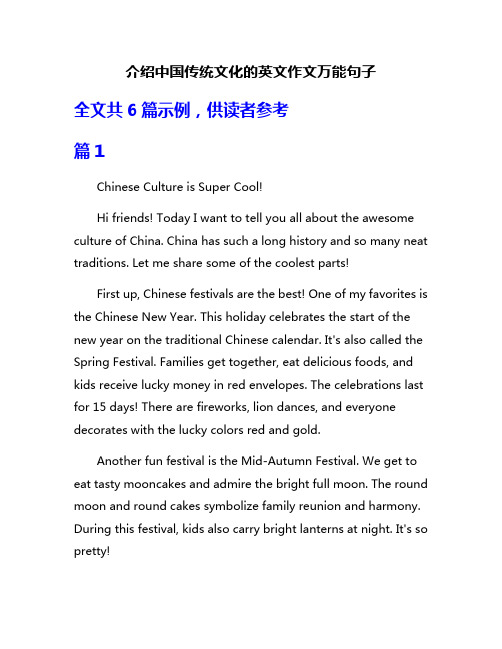
介绍中国传统文化的英文作文万能句子全文共6篇示例,供读者参考篇1Chinese Culture is Super Cool!Hi friends! Today I want to tell you all about the awesome culture of China. China has such a long history and so many neat traditions. Let me share some of the coolest parts!First up, Chinese festivals are the best! One of my favorites is the Chinese New Year. This holiday celebrates the start of the new year on the traditional Chinese calendar. It's also called the Spring Festival. Families get together, eat delicious foods, and kids receive lucky money in red envelopes. The celebrations last for 15 days! There are fireworks, lion dances, and everyone decorates with the lucky colors red and gold.Another fun festival is the Mid-Autumn Festival. We get to eat tasty mooncakes and admire the bright full moon. The round moon and round cakes symbolize family reunion and harmony. During this festival, kids also carry bright lanterns at night. It's so pretty!Speaking of food, Chinese cuisine is out of this world! There are so many flavors and regional styles. My favorites are dumplings, noodles, and Peking duck. Mmm, my mouth is watering just thinking about it! An important part of the meal is using chopsticks to eat. It takes practice, but once you get the hang of it, chopsticks are super cool to use.Chinese arts and crafts are amazing too. One example is calligraphy - the beautiful art of fancy writing and brushwork. The tools are a brush, ink stone, and rice paper. Writing the characters looks almost like a dance! Another craft is paper folding called zhezhi. You can make clever designs like dragons and phoenixes just by folding pieces of paper in special ways.Then there are the famous Chinese inventions that changed the world! Things you might use every day like paper, printing, the compass, and gunpowder were first created in ancient China. Can you imagine your life without those handy items? Pretty crazy, right?Those are just a few highlights of the rich Chinese culture. There is still so much more I could discuss, like traditional Chinese medicine, martial arts, silk making, jade carving, and ancient philosophical teachings. China has contributed countlesscustoms, innovations, and wisdom to human civilization over its 5,000 year history.I feel so lucky to be able to learn about my cultural roots from a young age. The Chinese traditions of honor, discipline, creativity and diligence will help guide me to become a good person. While modern life is rapidly changing, it's important to keep these long-standing values alive. I hope more people around the world can come to appreciate the splendor and significance of Chinese culture!篇2My Favorite Chinese TraditionsHi there! My name is Xiao Ming and I'm 10 years old. I live in Beijing with my mom, dad, and little sister Mei Mei. Today I want to tell you about some of my favorite parts of Chinese culture that my family celebrates and practices.One of the biggest traditions is Chinese New Year! This is the most important holiday we celebrate each year. Everything starts with a huge cleaning of the whole house to sweep away bad luck from the old year. Then my mom buys lots of yummy snacks and fresh fruit. We decorate with red lanterns, couplets with good luck sayings, and paintings of the zodiac animal for that year.On New Year's Eve, our whole family gets together for a huge feast called the Reunion Dinner. We have all kinds of delicious dishes like dumplings, noodles for long life, whole steamed fish for abundance, and sweet rice balls. After dinner, we stay up late setting off firecrackers and fireworks at midnight to ring in the new year!The next day, it's tradition to wake up early and dress in new clothes from head to toe for good luck. Kids like me get hung bao, which are little red envelopes with money inside as a gift. We're not allowed to sweep or take out trash for a couple weeks so we don't sweep away the good luck. For two weeks, there are lion dances, temple fairs, and dragon dances in the streets to celebrate!Another big tradition is the Mid-Autumn Festival. This holiday honors the big, bright, beautiful full moon. A couple weeks before, my grandma teaches my sister and me to make mooncakes. These are thick pastries stuffed with lotus seed paste or other fillings, and they are shaped like the full moon.On the night of the festival, my whole family gets together to eat mooncakes and sip tea under the moon. We try to spot the jade rabbit on the moon's surface! My favorite part is carrying brightly glowing lanterns shaped like animals through the parkwith all my cousins. Shanghai has the biggest lantern festival I've ever seen.Speaking of lanterns, another fun tradition is for the Lantern Festival at the end of New Year celebrations. My dad is an artist, so he always makes the most beautiful lanterns for us to hang up around the house and courtyard. When I was little, we would go to temple fairs and watch dragon dances weaving through the streets between bright, swaying lanterns. Now that I'm older, I get to carry a lantern myself in the evening parade!Chinese culture is filled with so many other amazing traditions too. I love hearing the legends behind them from my grandparents. Like the story of the household gods who check on each family before New Year and report to the Jade Emperor in heaven. Or the tale of Zhi Nu the cloud weaver and Niu Lang the cowherd, whose forbidden love is honored on Qixi or the Double Seventh Festival.Another favorite is Qingming Festival in the spring, when we visit our ancestors' graves, burn incense, and make offerings of their favorite foods and fresh flowers. It reminds me of the importance of honoring those who came before us.There are so many brilliant Chinese inventions that are still used today too! Printing, paper making, the compass,gunpowder, the abacus for math—all of these amazing things originated in ancient China. We even had the first robot! It was an automatic wine server made of bamboo and string.I'm also very proud of Chinese arts and crafts like calligraphy, painting, paper cutting, jade carving, kite making, pottery, and embroidery. My aunt is an incredible painter and she teaches me Chinese brush painting techniques. I'm trying to learn to write with a brush and ink too.Chinese medicine is fascinating as well. Practitioners use herbs, acupuncture, massage, and practices like tai chi and qigong to promote health and balance in the body. My grandpa does tai chi in the park every morning and says it's a great way to start the day.There are just so many brilliant accomplishments, beautiful arts, delicious cuisine, ancient philosophies, and fun celebrations in Chinese culture. I feel very lucky to be able to participate in these rich traditions. Maybe you'd like to experience some too! Let me know if you have any other questions.篇3Traditional Chinese Culture is Super Cool!Hey there! I'm going to tell you all about the awesome traditional culture from China. It's been around for thousands of years and has so many fascinating parts to it. Get ready to learn some really neat stuff!First up, let's talk about Chinese characters. They look like beautiful little pieces of art, with each one representing a word rather than just a letter sound. Writing in Chinese characters takes a ton of practice, but once you get the hang of it, it's almost like painting a mini picture every time you write something down. There are so many characters too - tens of thousands! My grandparents can read and write way more than I can.Speaking of my grandparents, a big part of Chinese culture is respect for elders and ancestors. We have special holidays just for honoring our older family members and those who came before us. During festivals like Qingming, we visit the graves of our ancestors, clean them up, and leave offerings of food, flowers and incense. On the Lunar New Year, kids get lucky red envelopes with money inside from the grown-ups. It's a way of passing on good fortune.Then there are all the amazing Chinese arts and crafts. Calligraphy is the beautiful handwriting of Chinese characters.True masters can make the ink flow and dance across the paper. Chinese painting has been around for ages, capturing landscapes, flora and fauna with detailed brushstrokes. My favorite is probably paper cutting though - creating intricate designs by folding and snipping away at colorful paper. It's almost like magic!I can't talk about Chinese culture without mentioning the food! Oh man, the food is out of this world delicious. Every region has its own special dishes and flavors. In the north, they love doughy things like dumplings and noodles. In the south, the cuisine features lots of rice and seafood. Then you've got Sichuan food which is crazy spicy but so tasty. My mouth waters just thinking about it!Two philosophies that are really important in Chinese thinking are Taoism and Confucianism. Taoism teaches ideas like going with the flow and finding balance and harmony in nature. Confucianism is more about ethics, morals, and social roles. Showing respect, working hard, and being a good person are key Confucian values. Both have influenced Chinese culture immensely over the centuries.I could ramble on forever about Chinese martial arts like kung fu, traditional medicine practices, Beijing Opera with all itsbright costumes and masks, or Chinese inventions like the compass, gunpowder, and printing. But I'll stop here so I don't overload your brain!Chinese culture is just endlessly fascinating to me. From the very first script carved into oracle bones to the modern skyscrapers of cities like Shanghai, it has such an amazingly long and rich history. Preserving traditions while also adapting to new times is something the Chinese people have done brilliantly over the millennia. I'm so fortunate to be part of this wonderful heritage. If you ever get the chance to experience aspects of traditional Chinese culture, I highly recommend it!篇4Chinese Culture is Awesome!Hi friends! Today I want to tell you all about the amazing culture of China. There's just so much to share about the oldest continuous civilization on Earth. Get ready to learn some super cool stuff!Let's start with Chinese writing. Did you know Chinese characters are one of the oldest written languages still in use? The earliest written characters date back over 3,000 years! Modern Chinese has tens of thousands of characters, whichoriginate as small pictures representing objects, ideas or sounds.I think it's awesome how each little squiggle holds such deep meaning.Chinese arts and crafts are renowned worldwide for their beauty and craftsmanship. Take ceramics for example - Chinese potters were the first to develop fired glazes, way back in the Shang Dynasty over 3,500 years ago! They made gorgeous glazed stoneware in vibrant colors like jade green and sapphire blue. Chinese silk is another famous export, originally reserved only for imperial royalty. It comes from the silkworm, and its production was a closely guarded secret for centuries.Speaking of secrets, let me tell you about Chinese martial arts! Styles like kung fu, with its rapid kicks and punches, actually originated as military training over 2,000 years ago. Masters studied not just combat, but meditation, philosophy and traditional medicines too. So cool!Chinese philosophy has had a huge impact on culture over the millennia. There's Confucianism, which emphasizes ethics, propriety and social harmony. Confucius was a wise teacher who lived around 500 BC. His philosophy guides relationships, from family to government. Then there's Taoism, focused on livingsimply and in harmony with nature. The famous Taoist Book of Changes is over 3,000 years old!No introduction to Chinese culture would be complete without mentioning the amazing architecture. The Forbidden City in Beijing is a massive 180-acre palace compound with nearly 1,000 buildings! It was home to 24 emperors during the Ming and Qing dynasties. With its red walls, yellow glazed roof tiles, white marble and intricate carved wood, it's a breathtaking example of traditional palace architecture.And then there are the amazing festivals! Chinese New Year is the biggest, with red lanterns, fireworks, dumplings and giving out red envelopes with money inside for good luck. TheMid-Autumn Festival celebrates the fall harvest with mooncakes and colorful lanterns. During Qingming Festival, families visit ancestor graves to pay respects. The Dragon Boat Festival has super exciting boat races and eating zongzi, sticky rice wrapped in bamboo leaves!Oh man, I could go on and on about China's rich heritage. From jade carvings to shadow puppetry, from traditional medicine to the games of go and mahjong, there's just so much awesome stuff! Four thousand years of continuous history have created one of the most vibrant and profound cultures on ourplanet. I hope you've enjoyed learning a bit about the wonders of Chinese civilization. It really is something every kid should know about. Thanks for reading, and let me know if you have any other questions!篇5China Has Such Cool Traditions!Did you know that China is one of the oldest civilizations in the world? It has a really rich culture filled with amazing customs, celebrations, and philosophies that have been passed down for thousands of years. Let me tell you about some of the coolest traditions from my awesome country!One of the biggest holidays in China is Chinese New Year. It's kind of like Christmas, but way more exciting! The celebration lasts for 15 whole days. On New Year's Eve, families get together for a huge feast with dishes like dumplings, noodles, fish, and sticky rice cakes. We decorate our houses with red lanterns, couplets, and paper cuts. The color red is super lucky. At midnight, we set off a ton of firecrackers and fireworks to scare away evil spirits. How awesome is that?For the next two weeks, we visit relatives and friends, eat delicious foods, watch dragon and lion dances, and get redenvelopes filled with money! My favorite part is whenthewhole neighborhood comes alive with festivities. There are dragon parades with people dressed up in vibrant costumes juggling balls and ribbons. It's such a joyful, lively celebration of the new year.Speaking of dragons, they are very important in Chinese mythology and culture. They symbolize power, strength, and good luck. You see dragon images and motifs everywhere - on buildings, clothing, artwork. Chinese dragons look way cooler than Western dragons too. Ours have long, snake-like bodies covered in scales, with four legs and expressive faces. Some have deer-like antlers or flowing manes. Ancient rulers even used the dragon symbol to represent their imperial power.Another super important tradition is the philosophy of yin and yang. It's the idea that all things in the universe have two opposing but complementary forces - the yin (dark, feminine, passive) and the yang (light, masculine, active). These energies need to be balanced and harmonious for there to be order in the world. The yin yang symbol, with the swirl of black and white teardrops, represents this concept. It reminds us that within each opposing force contains a seed of the other. Pretty deep for such a simple design, right?I can't forget to mention some Chinese martial arts, which are over 2,000 years old! Kung fu movies with guys doing crazy kicks and punches are popular worldwide. But the practice of kung fu is not just about fighting. It emphasizes moral ethics, spiritual discipline, and finding inner peace. Some of thebest-known styles are Shaolin kung fu, with its intense training at the ancient Shaolin Buddhist monastery, and tai chi, with its slow, graceful movements. Martial arts masters have almost superhuman abilities - they can smash concrete with their heads, walk on sharp nails, and use secret pressure points to defeat opponents!Those are just a few highlights of China's awesome cultural heritage. There's so much more I could tell you about - traditional Chinese medicine, calligraphy, opera, literature, crafts, and architecture. Just exploring Beijing's Forbidden City palace or walking along the Great Wall gives you a sense of China's grand history and traditions. I feel really lucky to come from such an ancient, rich civilization. Don't you think Chinese culture is amazing? I can't wait to learn more about it as I get older!篇6My Awesome Chinese CultureChina is an amazing country with a super long history and lots of awesome culture! I love learning about the traditions of my homeland. Here are some of the coolest parts of Chinese culture:FoodYum, yum, yum! Chinese food is the best. We have so many delicious dishes and snacks. My favorites are dumplings, noodles, and Peking duck. Dumplings are little pouches stuffed with tasty fillings like pork and vegetables. You can boil them, steam them, or fry them. Noodles come in long strings that you slurp up. And Peking duck is a whole roasted duck with crispy skin that gets brushed with a sweet sauce. My mouth is watering just thinking about it!Another Chinese food tradition is to use chopsticks instead of forks and spoons. Chopsticks are two skinny sticks that you hold in one hand to pick up food. It takes practice to get good at using chopsticks, but once you learn, it's fun!FestivalsChina celebrates a lot of exciting festivals every year. My favorite is the Chinese New Year! It's also called the Spring Festival. This holiday lasts for 15 days and is a time for familyreunions, eating special foods, and setting off fireworks and firecrackers. Houses get decorated with red lanterns, couplets, and papercuts. Kids receive red envelopes filled with money as gifts. The loud fireworks are supposed to scare away evil spirits for the new year.Another big celebration is the Mid-Autumn Festival. It happens when the moon is roundest and brightest in the fall. Families get together to admire the full moon, eat mooncakes (a dense sweet cake), and share the legend of Chang'e, the mythical lady on the moon.Arts and CraftsThe traditional arts and crafts of China are awesome! I love the ink wash paintings of landscapes with their soft brushstrokes and splashes of black ink. Chinese calligraphy, or brush writing, is also beautiful. The calligraphers have to practice for years to perfect the elegant flowing strokes.One of the coolest Chinese crafts is paper folding and cutting. People fold and snip away at colorful paper to create intricate designs called paper cuts. They are usually designs of characters, animals, or flowers with lots of tiny, detailed cuts. The papercuts are used to decorate windows or lanterns for festivals.Another traditional craft is making clay figurines. Little statues of people, animals, and mythical creatures are molded and painted with bright colors and patterns. During holidays, every household will display these vibrant clay figurines.Beliefs and StoriesChina has a lot of fascinating traditional beliefs and folk tales that have been passed down for thousands of years. Many of the stories try to teach good values like being kind, working hard, and respecting your elders.For example, there is the legend of the Jade Rabbit. As the story goes, a poor rabbit once jumped into a fire to provide food for the hungry. The rabbit's noble sacrifice was so brave that the gods were touched. They immortalized the rabbit by placing its image on the moon as a symbol of selflessness.Other myths tell about deities and supernatural creatures. The Dragon King is said to be the ruler of all waters and ability to control rain and floods. The Phoenix is a magical bird that appears only in times of peace and prosperity as a symbol of harmony. I love hearing about these magical tales!China has many traditional beliefs about luck, fortune, and symbolism too. The numbers 8 and 9 are considered very lucky,while 4 is unlucky. Certain colors, animals, and objects are seen as auspicious symbols for good luck, wealth, longevity, or fertility. For instance, goldfish represent abundance, while cranes signify long life.Traditional ClothingChinese people have such awesome traditional styles of dress. Many outfits feature bright colors, elaborate patterns, and intricate knots or fastenings.For ladies, there is the qipao or cheongsam dress. This is a tight-fitting dress with a high collar and fancy patterns and frog button closures up the sides. Another beautiful women's garment is the long trailing dress with billowing sleeves called an ao dai.For men, the traditional look is a long silk robe called a changshan. It has a mandarin collar and may be plain or decorated with embroidery and knotted buttons.Many of the clothes, accessories, and shoes incorporate symbols like dragons, phoenixes, peonies, or geometric shapes that were thought to bring good luck and fortune. Even the knots and fasteners could carry meanings of health, wealth, or long life.I feel so proud learning about the incredible traditions, arts, and culture of my Chinese heritage. China has such a depth of rich customs that have been carefully passed down from ancient times until today. I hope you found some parts of it interesting too! Let me know if you want to hear more awesome details about life in the Middle Kingdom.。
中国传统文化介绍(英文版)
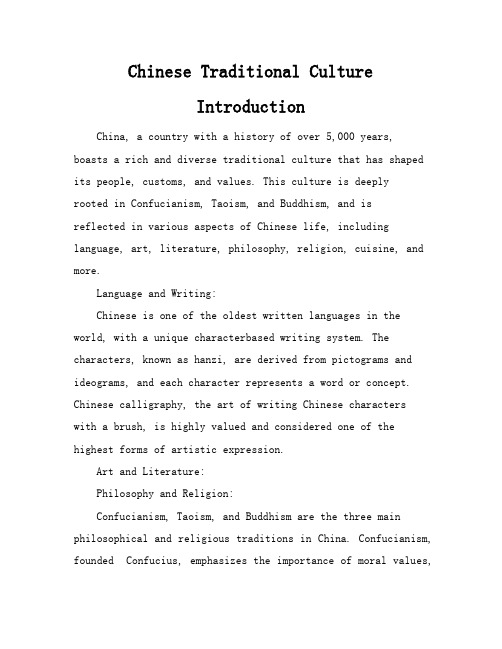
Chinese Traditional CultureIntroductionChina, a country with a history of over 5,000 years, boasts a rich and diverse traditional culture that has shaped its people, customs, and values. This culture is deeplyrooted in Confucianism, Taoism, and Buddhism, and isreflected in various aspects of Chinese life, including language, art, literature, philosophy, religion, cuisine, and more.Language and Writing:Chinese is one of the oldest written languages in the world, with a unique characterbased writing system. The characters, known as hanzi, are derived from pictograms and ideograms, and each character represents a word or concept. Chinese calligraphy, the art of writing Chinese characterswith a brush, is highly valued and considered one of the highest forms of artistic expression.Art and Literature:Philosophy and Religion:Confucianism, Taoism, and Buddhism are the three main philosophical and religious traditions in China. Confucianism, founded Confucius, emphasizes the importance of moral values,social harmony, and filial piety. Taoism, founded Laozi, emphasizes the pursuit of harmony with nature and the Tao, or the Way. Buddhism, which originated in India, focuses on the Four Noble Truths and the Eightfold Path as a means to achieve enlightenment and escape suffering.Cuisine:Chinese cuisine is one of the most diverse and flavorful in the world, with a wide variety of regional styles and dishes. Some of the most famous Chinese dishes include Peking duck, dim sum, hot pot, and dumplings. Chinese cooking techniques are also diverse, including stirfrying, steaming, boiling, and roasting.Festivals and Celebrations:China has a rich tradition of festivals and celebrations, many of which are based on the lunar calendar. Some of the most important festivals include the Spring Festival (Chinese New Year), the MidAutumn Festival, the Dragon Boat Festival, and the Lantern Festival. These festivals are celebrated with traditional customs, such as lighting lanterns, eating special foods, and watching fireworks.Traditional Medicine:Traditional Chinese medicine (TCM) is a holistic system of medicine that has been practiced for thousands of years. TCM emphasizes the balance of yin and yang, and the use ofherbal remedies, acupuncture, and other treatments to promote health and wellbeing.Conclusion:Chinese traditional culture is a treasure trove of knowledge, wisdom, and beauty. It continues to influence the lives of people in China and around the world, and is a valuable resource for understanding the history and development of human civilization.ContinuedArchitecture and Gardens:Chinese architecture is renowned for its intricate designs, use of wood, and emphasis on harmony with nature. Traditional Chinese buildings often feature curved roofs, red columns, and decorative elements such as dragons and phoenixes. Chinese gardens, known for their balance of water, rocks, plants, and architecture, are designed to create a serene and contemplative atmosphere.Music and Dance:Chinese music has a long history, with various instruments such as the guqin (a sevenstringed zither), erhu (a twostringed fiddle), and pipa (a fourstringed lute). Traditional Chinese dance is also diverse, ranging from优雅的宫廷舞到欢快的民间舞,每一种舞蹈都有其独特的风格和意义。
中国文化英语作文
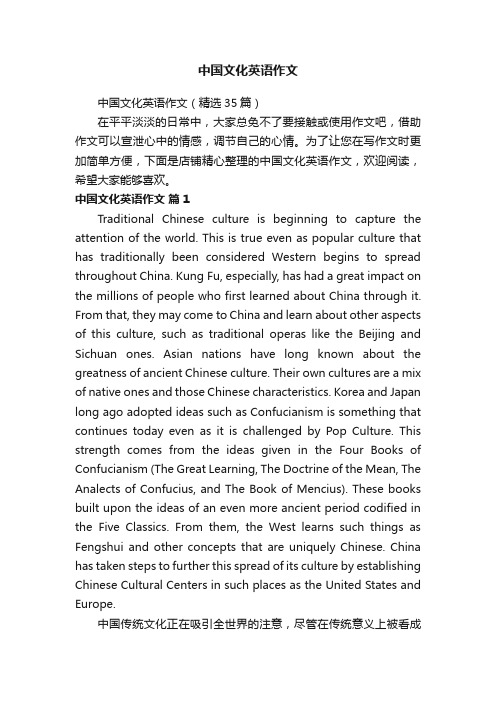
中国文化英语作文中国文化英语作文(精选35篇)在平平淡淡的日常中,大家总免不了要接触或使用作文吧,借助作文可以宣泄心中的情感,调节自己的心情。
为了让您在写作文时更加简单方便,下面是店铺精心整理的中国文化英语作文,欢迎阅读,希望大家能够喜欢。
中国文化英语作文篇1Traditional Chinese culture is beginning to capture the attention of the world. This is true even as popular culture that has traditionally been considered Western begins to spread throughout China. Kung Fu, especially, has had a great impact on the millions of people who first learned about China through it. From that, they may come to China and learn about other aspects of this culture, such as traditional operas like the Beijing and Sichuan ones. Asian nations have long known about the greatness of ancient Chinese culture. Their own cultures are a mix of native ones and those Chinese characteristics. Korea and Japan long ago adopted ideas such as Confucianism is something that continues today even as it is challenged by Pop Culture. This strength comes from the ideas given in the Four Books of Confucianism (The Great Learning, The Doctrine of the Mean, The Analects of Confucius, and The Book of Mencius). These books built upon the ideas of an even more ancient period codified in the Five Classics. From them, the West learns such things as Fengshui and other concepts that are uniquely Chinese. China has taken steps to further this spread of its culture by establishing Chinese Cultural Centers in such places as the United States and Europe.中国传统文化正在吸引全世界的注意,尽管在传统意义上被看成是西方文化的流行文化开始在中国广泛传播。
中国传统文化介绍(英文版)

Introduction to Chinese TraditionalCultureChina, with a history spanning over 5,000 years, boasts a rich and profound traditional culture that has shaped the country's identity and influenced countless aspects of daily life. This document aims to provide an overview of Chinese traditional culture, highlighting its key elements and their significance in Chinese society.1. Language and Literature2. Philosophy and ReligionChinese traditional culture is deeply rooted in Confucianism, Taoism, and Buddhism. Confucianism emphasizes the importance of moral integrity, respect for authority, and the pursuit of harmony in relationships. Taoism advocates for a simple, natural life and the pursuit of inner peace. Buddhism, introduced from India, has integrated with Chinese culture, influencing art, architecture, and everyday life.3. Art and CraftsmanshipChinese art is renowned for its exquisite craftsmanship and aesthetic appeal. Traditional Chinese painting, calligraphy, and porcelain are highly valued worldwide. The art of silk weaving, papermaking, and jade carving showcasesthe ingenuity and skill of Chinese artisans. Moreover, the practice of Feng Shui, which aims to harmonize the flow of energy in a space, reflects the Chinese belief in the interconnectedness of nature and human life.4. Festivals and CustomsChinese festivals are a vibrant display of the country's cultural heritage. The Spring Festival (Chinese New Year) is the most important holiday, featuring traditional activities such as dragon and lion dances, fireworks, and family reunions. Other notable festivals include the Lantern Festival, Dragon Boat Festival, and MidAutumn Festival, each with its unique customs and traditions.5. Traditional ClothingThe Hanfu, a traditional Chinese attire, reflects the elegance and diversity of Chinese culture. Characterized its flowing lines and vibrant colors, Hanfu represents different social status, occasions, and historical periods. The Tang suit and Qipao are also iconic examples of Chinesetraditional clothing, showcasing the beauty and grace of Chinese women.In conclusion, Chinese traditional culture is a treasure trove of wisdom, art, and values that continue to shape the lives of people in China and around the world. By exploringthese cultural elements, we can gain a deeper understandingof the Chinese perspective on life, nature, and humanity.6. Culinary DelightsChinese cuisine is a vital part of its traditional culture, renowned for its diversity and emphasis on harmonyin flavors and ingredients. The practice of using a pair of chopsticks is not only a dining custom but also a reflectionof Chinese philosophy. Signature dishes such as Peking duck, hot pot, dim sum, and Sichuan spicy tofu (Mapo tofu)represent the rich tapestry of regional cuisines within China. The art of tea making and tea ceremonies further illustratethe Chinese pursuit of balance and tranquility in daily life.7. Architecture and GardensChinese architecture is characterized its use of wood, intricate carvings, and upturned eaves. The Forbidden City in Beijing and the classical gardens of Suzhou are prime examples of Chinese architectural excellence. Thesestructures are not only beautiful but also embody theprinciples of Feng Shui and the concept of harmony between humanity and nature. The gardens, in particular, are designed to mimic natural landscapes, providing a serene environmentfor contemplation and relaxation.8. Music and DanceChinese traditional music, with its unique scales and instruments such as the guzheng (zither), erhu (fiddle), and pipa (lute), creates a distinctive sound that is both soothing and evocative. Chinese classical dance, often performed in colorful costumes with flowing movements, tells stories and expresses emotions, drawing from historical legends and folk tales. The Peking Opera, with its elaborate costumes, makeup, and singing styles, is a famous form of traditional Chinese performing art.9. Martial Arts10. Social EtiquetteChinese society places a strong emphasis on respect, modesty, and humility. The concept of "face" (mianzi) is crucial in social interactions, representing one's reputation and social standing. Traditional greetings, such as bowing or clasping hands, and the exchange of business cards with both hands, demonstrate the importance of etiquette in Chinese culture. The practice of giftgiving, with its specific customs and taboos, is also a reflection of the respect and consideration shown in relationships.In exploring the depths of Chinese traditional culture, one cannot help but be inspired its richness and the enduring legacy it has left on the world. It is a culturethat invites us to look inward, to appreciate the beauty in simplicity, and to find harmony in the world around us.11. Folklore and MythologyChinese folklore and mythology are a tapestry of stories and legends that have been passed down through generations. These tales often feature mythical creatures like the dragon, phoenix, and qilin, which symbolize power, prosperity, and good fortune. Stories such as "Journey to the West," "Water Margin," and "The Investiture of the Gods" are not only literary masterpieces but also reflect the moral values and cultural norms of ancient China. These myths and legends continue to influence modern Chinese literature, film, and popular culture.12. Traditional Medicine13. Family ValuesFamily is the cornerstone of Chinese society, and traditional values place a strong emphasis on filial piety and ancestor worship. Elders are respected for their wisdom and experience, and the concept of "family" extends beyond the nuclear unit to include extended relatives. The family name (surname) is a source of pride and identity, often passed down through generations with a sense of duty to honor one's ancestors. The importance of family is reflected in thecelebration of festivals, where family reunions are a central tradition.14. Education and the Art of LearningEducation has always been highly valued in Chinese culture, with a focus on the pursuit of knowledge and the cultivation of moral character. The ancient Chinese education system emphasized the Four Arts: qin (a string instrument), shu (calligraphy), hua (painting), and qi (the game of Go). Today, the Chinese education system continues to be rigorous, with a strong emphasis on academic achievement and the Confucian values of respect for teachers and the importance of learning.15. Ceremonies and RitualsChinese culture is rich with ceremonies and rituals that mark life's milestones, such as births, weddings, and funerals. These events are often steeped in tradition, with specific customs and rituals that have been followed for centuries. For instance, Chinese weddings are filled with symbolic gestures, such as the exchange of red envelopes (hongbao), the tea ceremony, and the wearing of traditional attire. These rituals are not only celebratory but also serve to reinforce cultural identity and continuity.In conclusion, the depth and breadth of Chinesetraditional culture are truly aweinspiring. It is a livingheritage that continues to evolve while maintaining its roots in ancient wisdom. By understanding and appreciating these cultural elements, we gain insight into the soul of a civilization that has shaped and continues to shape the world in countless ways.。
中国文化概况总结英文作文
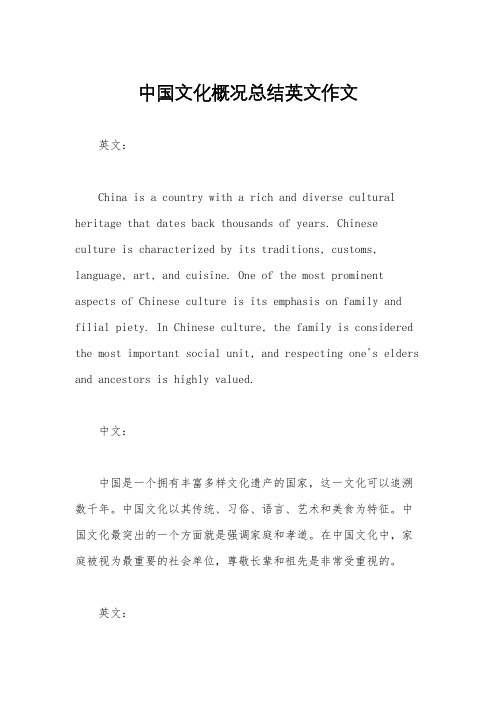
中国文化概况总结英文作文英文:China is a country with a rich and diverse cultural heritage that dates back thousands of years. Chineseculture is characterized by its traditions, customs, language, art, and cuisine. One of the most prominent aspects of Chinese culture is its emphasis on family and filial piety. In Chinese culture, the family is considered the most important social unit, and respecting one's elders and ancestors is highly valued.中文:中国是一个拥有丰富多样文化遗产的国家,这一文化可以追溯数千年。
中国文化以其传统、习俗、语言、艺术和美食为特征。
中国文化最突出的一个方面就是强调家庭和孝道。
在中国文化中,家庭被视为最重要的社会单位,尊敬长辈和祖先是非常受重视的。
英文:Chinese cuisine is also a significant part of the country's culture. Each region in China has its own unique culinary traditions and specialties. For example, Sichuan cuisine is known for its bold and spicy flavors, while Cantonese cuisine is famous for its delicate and fresh ingredients. Chinese food is not only about taste, but also about the presentation and the balance of flavors.中文:中国美食也是中国文化的重要组成部分。
英语作文介绍中国文化

英语作文介绍中国文化英文回答:China has a rich and diverse cultural heritage that has been shaped by thousands of years of history. One of the most iconic aspects of Chinese culture is its traditional cuisine. Chinese food is known for its bold flavors and unique cooking techniques. For example, the dish "Kung Pao chicken" is a famous Sichuan dish that is known for its spicy and savory flavors. It is made with chicken, peanuts, and spicy chili peppers, and is a popular dish both in China and around the world. Another famous Chinese dish is "Peking duck," which is a roasted duck dish that is known for its crispy skin and tender meat. These dishes are just a small example of the wide variety of delicious foods that are part of Chinese culinary tradition.In addition to its cuisine, Chinese culture is also known for its traditional festivals and celebrations. For example, the Chinese New Year, also known as the SpringFestival, is a time when families come together tocelebrate and honor their ancestors. During this time, people often exchange red envelopes filled with money as a symbol of good luck and prosperity for the coming year. Another important festival is the Mid-Autumn Festival,which is a time for families to gather and enjoy mooncakes while appreciating the beauty of the full moon. These festivals are an important part of Chinese culture and are celebrated with great enthusiasm and joy.中文回答:中国拥有丰富多样的文化遗产,这些文化传统经过数千年的历史沉淀而形成。
向外国朋友介绍中国传统文化的英语作文

向外国朋友介绍中国传统文化的英语作文英文版:Dear friends,I would like to introduce you to one of the most fascinating aspects of Chinese traditional culture - Chinese calligraphy. With a history of over 3,000 years, Chinese calligraphy is not only a form of art but also a way to cultivate one's mind and express emotions.In ancient China, calligraphy was considered one of the four essential skills that scholars must master, along with playing the guqin (a stringed instrument), playing go (an ancient board game), and painting. The tools used in calligraphy - brush, ink, paper, and inkstone - are known as the "Four Treasures of the Study."The beauty of Chinese calligraphy lies in its balance, composition, and the expression of the calligrapher's spirit. Each stroke, whether it is thick or thin, long or short, conveys a different emotion and energy. The way the characters are arranged on the paper also reflects the calligrapher's artistic sense and understanding of space.Learning Chinese calligraphy not only helps one appreciate the beauty of Chinese characters but also cultivates patience, concentration, and inner peace. It is a practice that allows one to slow down, focus on the present moment, and express oneself through the art of writing.I hope this brief introduction has piqued your interest in Chinese calligraphy. It is truly a gem in the treasure trove of Chinese traditional culture, and I encourage you to explore it further.Best regards,[Your Name]中文版:亲爱的朋友们:我想向大家介绍一下中国传统文化中最迷人的方面之一——中国书法。
中国文化 英文介绍(通用3篇)

中国文化英文介绍(通用3篇)关于中国文化的英文文章篇一Lucky number is part of our cultureTo my way of thinking, the so-called lucky number represents the characteristics of our culture. We Chinese have a tradition: whenever we have important things to do, we always select the day we think lucky. Such as: the “10.10.10” day (October 10, 2010), we regard it as the prefect day. For in our culture, “10” as a very lucky number means everything is perfect.This tradition is gradually formed in history. As we all know, china have a very long history. The nature is very sacred then, and our ancestors try their best in order to gain its help, hoping everything run smooth. So when they were to do things, they usually choose something which indicates good fortune. As the time passes, this habit slowly becomes a tradition, and gradually expands every aspect of life. For example, Chinese people like wear the red clothes, because in our eyes the red indicates positive, smooth, prosperous.Among this, the lucky number is the especial example. Now the number seems to appear everywhere in our daily life. Such as: our telephone number, various bank card number, ID number, VIP card number, house number and so on. The number four looked as unlucky, for its pronunciation sound as the word “death” in Chinese. So is the number seven. However, six, nine, ten are lucky numbers. Affected by this culture, most of us prefer to use the so-called lucky numbers. Therefore there are lots of couples choose the”8.8.8”“9.9.9””10.10.10”day when they marry.All in all, the lucky number is part of our culture. All things we can do are holding a respect and accept of attitude to it.中国文化英文介绍篇二京剧脸谱(Beijing opera types of facial makeup in operas)Beijing opera types of facial makeup in operas, is a special feature of a national cosmetic. As each historical figure or a certain type of person has an approximate spectral type, like sing, play music to the music, so called “types of facial makeup in operas”。
给外国朋友介绍中国的传统文化 英语作文
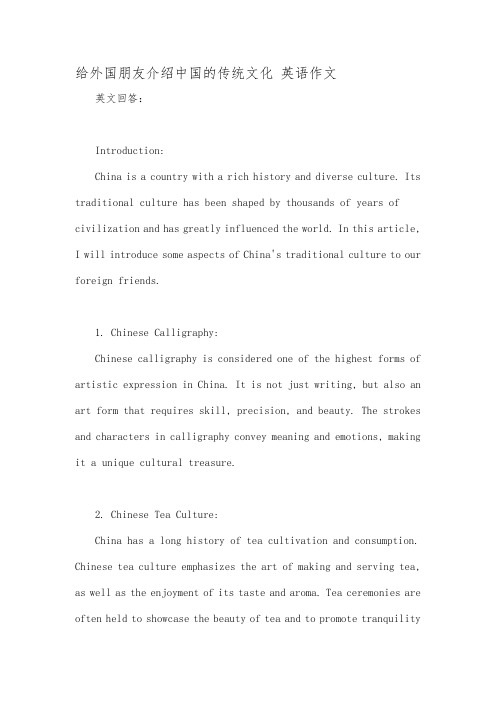
给外国朋友介绍中国的传统文化英语作文英文回答:Introduction:China is a country with a rich history and diverse culture. Its traditional culture has been shaped by thousands of years of civilization and has greatly influenced the world. In this article, I will introduce some aspects of China's traditional culture to our foreign friends.1. Chinese Calligraphy:Chinese calligraphy is considered one of the highest forms of artistic expression in China. It is not just writing, but also an art form that requires skill, precision, and beauty. The strokes and characters in calligraphy convey meaning and emotions, making it a unique cultural treasure.2. Chinese Tea Culture:China has a long history of tea cultivation and consumption. Chinese tea culture emphasizes the art of making and serving tea, as well as the enjoyment of its taste and aroma. Tea ceremonies are often held to showcase the beauty of tea and to promote tranquilityand harmony.3. Chinese Martial Arts:Chinese martial arts, also known as Wushu, have a history of thousands of years. It is not only a physical exercise but also a way to cultivate the mind and spirit. Martial arts such as Tai Chi and Kung Fu are not only about self-defense but also promote discipline, balance, and inner peace.4. Festivals and Traditions:China has numerous traditional festivals that are celebrated with great enthusiasm. The Spring Festival (Chinese New Year), the Lantern Festival, and the Mid-Autumn Festival are some of the most significant ones. These festivals are characterized by vibrant decorations, delicious food, and various cultural activities.Conclusion:China's traditional culture is a treasure trove of wisdom, art, and spirituality. By understanding and appreciating its richness, we can gain a deeper insight into the Chinese way of life. I hope this introduction to China's traditional culture has piqued your interest and encouraged you to explore further.中文回答:简介:中国是一个拥有悠久历史和多元文化的国家。
用英文讲中国文化 英语作文
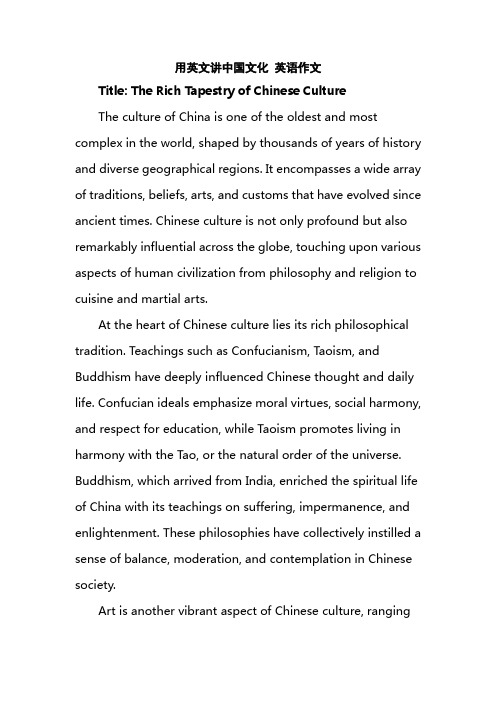
用英文讲中国文化英语作文Title: The Rich Tapestry of Chinese CultureThe culture of China is one of the oldest and most complex in the world, shaped by thousands of years of history and diverse geographical regions. It encompasses a wide array of traditions, beliefs, arts, and customs that have evolved since ancient times. Chinese culture is not only profound but also remarkably influential across the globe, touching upon various aspects of human civilization from philosophy and religion to cuisine and martial arts.At the heart of Chinese culture lies its rich philosophical tradition. Teachings such as Confucianism, Taoism, and Buddhism have deeply influenced Chinese thought and daily life. Confucian ideals emphasize moral virtues, social harmony, and respect for education, while Taoism promotes living in harmony with the Tao, or the natural order of the universe. Buddhism, which arrived from India, enriched the spiritual life of China with its teachings on suffering, impermanence, and enlightenment. These philosophies have collectively instilled a sense of balance, moderation, and contemplation in Chinese society.Art is another vibrant aspect of Chinese culture, rangingfrom the intricate designs on traditional ceramics to the grandeur of calligraphy and painting. Chinese calligraphy is more than just a form of writing; it is considered a dance of the brush, where each stroke embodies strength, rhythm, and emotion. Paintings often feature landscapes, imbued with philosophical meanings and a deep appreciation for nature's beauty. Traditional Chinese music, with its unique pentatonic scale, has been used to create melodies that are both soothing and expressive, often accompanied by instruments such as the pipa, an ancestor of the modern guitar, or the erhu, atwo-stringed bowed instrument.Celebrations and festivals occupy a special place in Chinese culture, serving both as markers of the passage of time and as opportunities for family reunions. The Spring Festival, or Chinese New Year, is the most significant event, a time when people welcome the new lunar year with fireworks, feasting, and family gatherings. The Mid-Autumn Festival celebrates the harvest moon with the gifting and consumption of mooncakes, symbolizing unity and completeness. These occasions, along with others like the Dragon Boat Festival and Qingming Festival, showcase the importance of kinship and communal solidarity.Chinese cuisine is perhaps one of the most widespread and beloved elements of Chinese culture globally. It varies vastly by region, reflecting the country's vast geography and climate differences. Signature dishes like Peking duck from the north and spicy Sichuan fare from the southwest offer a taste of China's culinary diversity. Rice, noodles, tea, and soups are staples in everyday meals, demonstrating the Chinese emphasis on balance and healthfulness in diet.Martial arts, often referred to in the West as "kung fu," are a testament to the Chinese philosophy of physical and spiritual discipline. Styles like Tai Chi combine self-defense techniques with principles of meditation and inner peace, making them both a physical exercise and a spiritual practice. Other forms, such as Shaolin martial arts, highlight a combination of agility, strength, and aerobic stamina, showcasing the athleticism and grace inherent in these practices.In conclusion, Chinese culture is a magnificent mosaic of historical depth, artistic splendor, philosophical profundity, and communal harmony. Its influence stretches far beyond China's borders, captivating and inspiring people around the globe. As one delves into the rich tapestry of China's culturalheritage, it becomes evident that this ancient culture embodies enduring wisdom and a way of life that values balance, reflection, and continuity with the past while embracing modernity and innovation.。
中国的文化介绍信英文作文

中国的文化介绍信英文作文英文,China is a country with a rich and diverseculture that has been shaped by thousands of years of history. From its ancient traditions to its modern innovations, Chinese culture is something that continues to captivate and inspire people all over the world.One of the most iconic aspects of Chinese culture isits cuisine. Chinese food is known for its bold flavors, diverse ingredients, and unique cooking techniques. Whether it's the fiery spiciness of Sichuan cuisine or the delicate flavors of Cantonese dishes, Chinese food offers something for every palate. For example, I remember the first time I tried authentic Peking duck in Beijing. The crispy skin and succulent meat left a lasting impression on me, and I've been a fan of Chinese cuisine ever since.Another integral part of Chinese culture is its traditional festivals and celebrations. The Chinese New Year, also known as the Spring Festival, is a time ofjoyous reunions and colorful parades. I still remember the excitement of watching dragon dances and fireworks with my Chinese friends during the Spring Festival. These traditions have been passed down through generations and continue to bring people together in celebration.In addition to its food and festivals, Chinese culture is also known for its rich history of art and literature. From ancient calligraphy to modern cinema, Chinese artists have made significant contributions to the world of creative expression. For example, the poetry of Li Bai and the paintings of Zhang Daqian continue to inspire artists and art enthusiasts around the globe.中文,中国是一个拥有丰富多样文化的国家,这个文化受到了数千年历史的影响。
中国的文化介绍信英文作文

中国的文化介绍信英文作文英文:China is a country with a rich and diverse culture that has been shaped by thousands of years of history. From the traditional customs and beliefs to the modern art and entertainment, Chinese culture is a fascinating and complex tapestry that continues to captivate people all over the world.One of the most iconic aspects of Chinese culture isits traditional festivals, such as the Spring Festival (Chinese New Year), Mid-Autumn Festival, and Dragon Boat Festival. These festivals are not only a time for families to come together and celebrate, but also an opportunity for people to learn about the country's history and traditions. For example, during the Spring Festival, people hang red lanterns and couplets on their doors to ward off evil spirits and bring good luck for the coming year. It's a time for reunion, feasting, and exchanging of red envelopescontaining money as a symbol of good fortune.Another integral part of Chinese culture is its cuisine. Chinese food is known for its diverse flavors, ingredients, and cooking techniques. Whether it's the spicy Sichuan cuisine, the savory Cantonese dim sum, or the aromatic Beijing roast duck, there is something for every palate.The Chinese saying "民以食为天" (mín yǐ shí wéi tiān) emphasizes the importance of food in people's lives, andthe act of sharing a meal is often seen as a way to strengthen social bonds and show hospitality.In addition to its traditions and cuisine, Chinese culture also boasts a rich tradition of art, literature,and philosophy. From the ancient poetry of Li Bai and Du Fu to the intricate brushwork of traditional Chinese painting, the country's artistic heritage is both diverse and profound. Chinese philosophy, with its emphasis on harmony, balance, and the interconnectedness of all things, has also had a profound influence on the country's culture and wayof life.中文:中国是一个拥有丰富多彩文化的国家,这种文化已经被数千年的历史所塑造。
介绍中国文化的英文作文80字
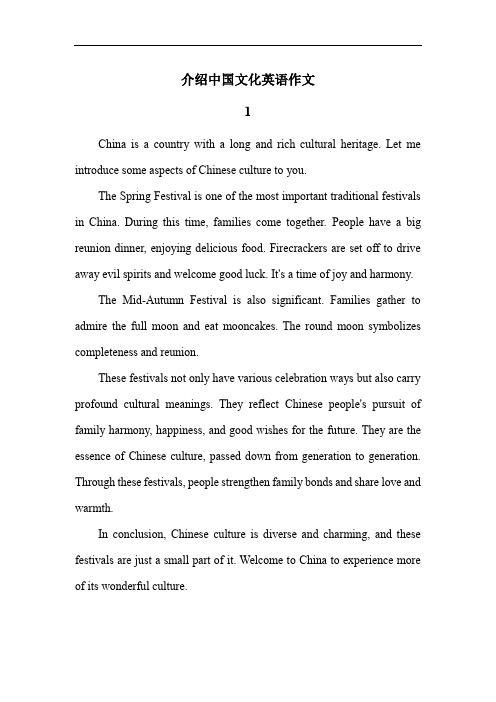
介绍中国文化英语作文1China is a country with a long and rich cultural heritage. Let me introduce some aspects of Chinese culture to you.The Spring Festival is one of the most important traditional festivals in China. During this time, families come together. People have a big reunion dinner, enjoying delicious food. Firecrackers are set off to drive away evil spirits and welcome good luck. It's a time of joy and harmony.The Mid-Autumn Festival is also significant. Families gather to admire the full moon and eat mooncakes. The round moon symbolizes completeness and reunion.These festivals not only have various celebration ways but also carry profound cultural meanings. They reflect Chinese people's pursuit of family harmony, happiness, and good wishes for the future. They are the essence of Chinese culture, passed down from generation to generation. Through these festivals, people strengthen family bonds and share love and warmth.In conclusion, Chinese culture is diverse and charming, and these festivals are just a small part of it. Welcome to China to experience more of its wonderful culture.China is a country with a long and rich cultural history. One of the most remarkable aspects of Chinese culture is its diverse and exquisite art forms.Calligraphy, for instance, is an art that reflects the beauty and depth of Chinese characters. The works of Wang Xizhi, a renowned calligrapher, are highly praised for their elegance and precision. His strokes are like a dance of the brush on paper, expressing the artist's emotions and thoughts.Painting is another splendid form of art. Chinese painters use traditional techniques and materials to create vivid and meaningful scenes. Their works often convey the harmony between humans and nature.Chinese opera, especially Peking Opera, is a unique performing art. The performances of Mei Lanfang, a famous Peking Opera master, are still unforgettable. His exquisite gestures, beautiful singing, and vivid expressions have left a deep impression on audiences.These art forms not only showcase the creativity and talent of the Chinese people but also carry the wisdom and spirit of the nation. They are the treasures of Chinese culture, attracting people from all over the world to explore and appreciate. Through these art forms, we can better understand the profound and charming Chinese culture.China has a rich and diverse culinary culture that is truly remarkable. Among the various aspects of Chinese cuisine, the Eight Culinary Traditions stand out with their unique characteristics and famous dishes.Sichuan cuisine is known for its bold and spicy flavors. Dishes like Mapo Tofu and Spicy Chicken are beloved for their intense heat and rich taste. The numbing spiciness of Sichuan peppers adds an unforgettable experience to the palate.Cantonese cuisine, on the other hand, emphasizes delicacy and refinement. Roast Goose and Dim Sum are prime examples of its exquisite cooking techniques and attention to detail. The fresh ingredients and delicate seasonings make each bite a treat.Shandong cuisine is famous for its emphasis on freshness and natural flavors. Braised Sea Cucumber and Sweet and Sour Pork are among its signature dishes.Huaiyang cuisine showcases the elegance and sophistication of Chinese cooking. Stewed Pork Balls and Yangzhou Fried Rice are popular choices.Each of the Eight Culinary Traditions offers a distinct flavor profile and reflects the regional diversity and cultural heritage of China. The exploration of Chinese cuisine is like a journey through a flavorful landscape, where every dish tells a story of tradition and innovation. It isnot only a source of sustenance but also a window into the depth and breadth of Chinese culture.4China has a profound and long-standing cultural heritage, among which philosophical thoughts play a vital role. Confucianism, represented by Confucius, emphasizes the concept of "benevolent governance". This idea holds that rulers should treat their subjects with kindness and morality, focusing on education and moral cultivation to create a harmonious society. For instance, providing equal opportunities for education and promoting moral standards among the people are key aspects of this thought.Another significant philosophy is Taoism, with Laozi advocating for "governing by doing nothing that goes against nature". It suggests that rather than excessive interference and control, one should follow the natural course of things and allow them to develop spontaneously. This approach emphasizes finding balance and harmony with nature, and not forcing outcomes.These philosophical ideas have not only influenced China's historical development but also have far-reaching implications for the modern world. They offer valuable insights into governance, interpersonal relationships, and the pursuit of a peaceful and balanced life. They remind us to respect nature, value morality, and strive for harmony in all aspects of life.5China is a country with a long history and rich culture. Among the many aspects that showcase its splendid civilization, traditional architecture stands out. Take the Forbidden City and the Great Wall as examples.The Forbidden City, an imperial palace complex, is a masterpiece of ancient Chinese architecture. Its elaborate design and magnificent buildings reveal the supreme power and exquisite taste of the emperors. Every detail, from the roof tiles to the carved pillars, is a testament to the superb craftsmanship of that era.The Great Wall is another remarkable symbol. Built over centuries, it has a profound history. Originally constructed for defense purposes, it has withstood the test of time and witnessed countless battles and changes. The massive stones and bricks were carefully laid, forming a barrier that stretches across mountains and valleys. It not only served as a military fortification but also became a cultural icon, representing the indomitable spirit and perseverance of the Chinese people.These traditional buildings are not just structures; they are the embodiment of Chinese wisdom, culture, and history. They tell stories of the past and inspire future generations to cherish and carry forward the precious heritage.。
- 1、下载文档前请自行甄别文档内容的完整性,平台不提供额外的编辑、内容补充、找答案等附加服务。
- 2、"仅部分预览"的文档,不可在线预览部分如存在完整性等问题,可反馈申请退款(可完整预览的文档不适用该条件!)。
- 3、如文档侵犯您的权益,请联系客服反馈,我们会尽快为您处理(人工客服工作时间:9:00-18:30)。
京剧是中国流行的最广泛影响最大的一个剧种,拥有两百多年的历史。在长期的发展过程中,京剧形成了一套虚拟表演动作,如一条桨就可以代表一只船。不需要任何的道具,演员就能表现出上楼、下楼,开门、关门等动作,虽然经赤了夸张但这些动作能给观众既真实又优美的感觉。京剧演员分生、旦、净、丑四个行当,生和旦的化痕迹要描眉、吊眉、画眼圈,净丑面部需要化妆,比如,红脸表示忠诚勇猛,白脸表示奸险。
Paper-Cuts
Chinesepaper-cuts are prettyandexquisite with auniqueoriental style. They makeviewerstofeel the realdaily life andafestiveatmosphere.The makingofpaper-cuts isapopular folk art ofmore than2000 yearsinChina.They aremostlycreatedbywomenin ruralareas. The designsare fowlsdomestic animals crops, episodesfrom operas auspicioussymbols andsoon.Usedon theChineselunarNewYear or otherfestivals, theyadddelightandfestivitytothe life oftheordinarypeople.Paper-cuts fall intotwocategories, simple and naturalsingle-coloredones,andgorgeousand colorfulones. Thefamous onesare window-panes from Shanxi,figurines oflocal operas from WeixianHebei,and embroidery copies in ethnic minoritiesinsouthernChina.Chinesepaper-cuthas been listed asoneofthe world’scultural heritages byUNESCO.
中国文化英文介绍
———————————————————————————————— 作者:
———————————————————————————————— 日期:
Coed QiustyledZhongni,agreatthinkerand educatorin the lateSpringand Autumn Period,and thefounder ofConfucianism. Confuciusinstructed morethan 3000disciples andsomewerefrompoor families.Confuciusgraduallychanged thetraditionthat onlynobilities had the righttoreceive education. Inhislater years ,Confucius compiledmanyliteraryworksofancient times,includingTheBookofSongs,TheBook of Documents, andTheBooksof Changes.His saying andbehaviors werecompiledinThe Analects of Confuciusby hisdisciples.Hisideology hasbeen absorbed and carried composing theessentialpartof Chinesetraditionalideology.It was also spread into the border regionsandareas buildingup a circleof Confucianism. UNESCOlabeled himoneof the“TenCulture Celebrities”.
孔子
孔子名丘字仲尼,春秋末期伟大的思想家和教育家,儒家学派创史人。孔子一共教授了三千多个学生,其中不乏贫困家庭的孩子,改变了只有贵族子女才有资格上学的传统。孔子晚年还编订上古书籍,《诗经》《尚书》《周易》等。孔子的言行被他的弟子们收集在《论语》中,他的思想也被后人吸收和发扬光大,成为中国传统思想最主要的组成部分,并逐渐传播到周边国家,形成了影响范围很广的儒家文化圈。联合国教科文组织曾将孔子列入世界十大文化名人之一。
Beijing Opera
BeijingOpera isthemostpopularand influential operainChina with a historyof almost 200 years.IndevelopmentBeijing Operahas formedanumberoffictitiousprops.For instanceapedalmeans aboat. Without anyphysicalpropsinvolved, an actormay performgoingupstairs ordownstairsopeningor closing adoorbymeregestures.Though exaggerated those actionswould giveaudienceanimpressionwithgraceful movements. There are fourmain rolessheng dan jingand chou.Asheng ordan hasthe eyebrowspainted andeyes circled. A jingandchouhavetheir facialmakeup,for example, a red facedepicts the loyaltyandbraveryand a whitefacesymbolizes treacheryandguile.
